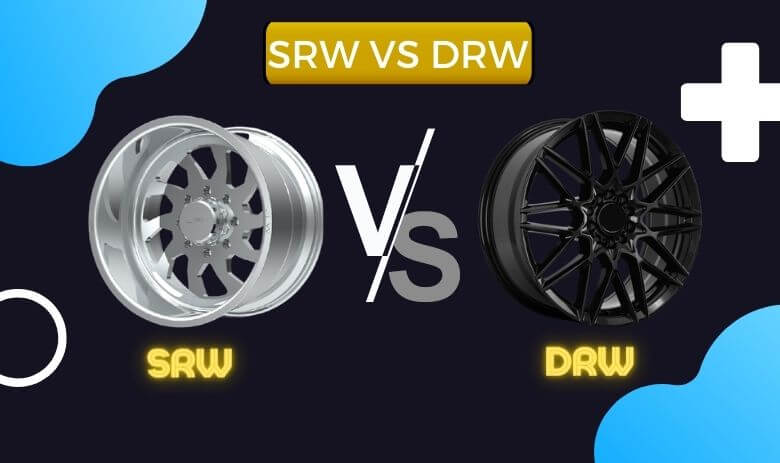Contents
SRW Vs DRW
It is essential to have the right kind of rear-wheel system to have an overall better and comfortable driving experience. The vehicles that we see around us have different types of wheels. But why do vehicles have different kinds of wheels? Mainly because the wheels of any particular vehicle decide the kind of payload the vehicle can carry.
Various types of wheels are available in the market. The two most common and basic kinds of wheels are SRW and DRW. Let us understand what SRW and DRW stand for. And further, in this article, we will figure out which one is best suited according to your needs.
What does SRW mean?
SRW stands for a Single Rear Wheel. It means that there is a single rear wheel present in the vehicle. In other words, it’s any regular vehicle that we see on a daily basis. Now let’s talk about SRW trucks; as elaborated before in this article, the rear wheels decide the kind of payload the truck may carry. Nowadays, we see trucks as a daily commute for many people; therefore, using the SRW can make this task easier.
What does DRW mean?
A DRW or dually is any vehicle with two pairs of rear wheels. DRW stands for Dual Rear Wheels. The extra pair of wheels help in spreading out the burden of trucks’ weight. It provides better surface contact with roads and provides a much better balance to the vehicle. Dually trucks are quite common to be seen on highways since the extra wheel provides them with a much bigger structure than the SRW.
Both are rear wheels, then what makes them different from each other, and which one should you opt for? Let us understand the difference between SRW and DRW in a much detailed way.
DRW VS SRW
Predominantly it comes down to the preferred towing capacity and the driving habits of the vehicle/truck owner. As we have come to understand, dually renders a higher towing capacity than its single rear wheel counterparts provide. The augmented base of the truck not only provides that it can tow more, but that it also gives the ability to maintain better stability.
Convenience in Daily Usage
As the DRW or dually has a wider rear base, it will take up much more space on the road; trucks having dual wheels sometimes take an entire lane on the highway. For heavy towing, this is necessary, but for daily usage, it becomes quite inconvenient, especially when it comes to parking the vehicle.
Even though some truck drivers boast of their capability of driving a huge vehicle through the busiest of lanes, why add the daily strain unless you are in dire need of the extra towing capacity?
The Cost of Maintenance
Let us understand the cost of maintenance that will be incurred if you have any of these real wheel systems in your vehicle. In dually, there’s a whole extra set of tires that needs to be maintained. That is an added cost for the DRW vehicles. Additionally, the wear and tear in DRW vehicles are much more than in the SRW vehicle.
DRW rear wheels have to be rotated routinely in order to distribute the wear and tear that they endure. So that is an added effort you will have to put in if you put the DRW rear-wheel system in your truck.
With SRW, the cost of maintenance is comparatively less. Even the wear and tear does not cost as much.
Towing Capacity
As we have understood earlier, the DRW rear-wheel system provides more towing capacity than the SRW rear-wheel system. Hence, they also offer a smoother, more stable ride.
Let us understand how “FORD” gives the experience of both SRW and DRW in its heavy-duty trucks. The ford -350 gives its customer the choice of both the DRW and SRW rear-wheel system.
Further, the ford -350, with its diesel engine and single rear wheels, can tow a maximum payload of 18,000 lbs while the dually of ford-350 can tow approximately 21,000 lbs. If combined with gooseneck towing, the payload capacity of dually increases even more.
Which rear-wheel system is best suited for your needs?
As we have understood, it all depends on your lifestyle and convenience and what kind of payload you wish to carry. If you want to tow heavy payloads like trailers, RV’s, boats, etc., then you should go for the DRW rear-wheel system. Moreover, the dually wheel system is much suited for rough terrains and rural life. If you get DRW in the city, your mileage will get reduced as well. However, if you want to use the truck for a lighter payload on a daily basis in between the city traffic, the SRW wheel system might just be the right choice for you.
Conclusion
It is pretty clear that the choice of rear-wheel system is intuitive and all depends on who is behind the wheels and how they plan to use the vehicles. However, this article might have given you some insights into the features of both the rear wheels systems. We hope you make an informed decision, and it gives you a smoother and better driving experience and fulfills your needs for which you are purchasing the vehicle.

